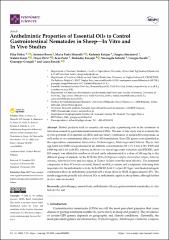| dc.contributor.author | Štrbac, Filip | |
| dc.contributor.author | Bosco, Antonio | |
| dc.contributor.author | Maurelli, Maria Paola | |
| dc.contributor.author | Ratajac, Radomir | |
| dc.contributor.author | Stojanović, Dragica | |
| dc.contributor.author | Simin, Nataša | |
| dc.contributor.author | Orčić, Dejan | |
| dc.contributor.author | Pušić, Ivan | |
| dc.contributor.author | Krnjajić, Slobodan | |
| dc.contributor.author | Sotiraki, Smaragda | |
| dc.contributor.author | Saralli, Giorgio | |
| dc.contributor.author | Cringoli, Giuseppe | |
| dc.contributor.author | Rinaldi, Laura | |
| dc.date.accessioned | 2022-07-22T08:15:36Z | |
| dc.date.available | 2022-07-22T08:15:36Z | |
| dc.date.issued | 2022 | |
| dc.identifier.citation | Štrbac, F.; Bosco, A.; Maurelli, M.P.; Ratajac, R.; Stojanovi´c, D.; Simin, N.; Orˇci´c, D.; Puši´c, I.; Krnjaji´c, S.; Sotiraki, S.; et al. Anthelmintic Properties of Essential Oils to Control Gastrointestinal Nematodes in Sheep—In Vitro and In Vivo Studies. Vet. Sci. 2022, 9, 93. https://doi.org/10.3390/ vetsci9020093 | en_US |
| dc.identifier.issn | 2306-7381 | |
| dc.identifier.uri | https://repo.niv.ns.ac.rs/xmlui/handle/123456789/545 | |
| dc.description.abstract | Herbal products such as essential oils may play a promising role in the treatment of
infections caused by gastrointestinal nematodes (GINs). The aim of this study was to evaluate the
in vitro potential of 11 essential oils (EOs) and one binary combination of isolated EO compounds, as
well as the in vivo anthelmintic efficacy of two EO formulations. Four GIN genera were identified in
the coproculture examination: Haemonchus, Trichostrongylus, Teladorsagia and Chabertia. The in vitro
egg hatch test (EHT) was performed at six different concentrations (50, 12.5, 3.125, 0.781, 0.195 and
0.049 mg/mL) for each EO, whereas in the in vivo faecal egg count reduction test (FECRT), each
EO sample was diluted in sunflower oil and orally administrated at a dose of 100 mg/kg to the
different group of animals. In the EHT, the EOs of Origanum vulgare, Foeniculum vulgare, Satureja
montana, Satureja hortensis and two types of Thymus vulgaris were the most effective. The dominant
compounds of these EOs were carvacrol, thymol, anethol, p-cymene and
-terpinene, indicating their
importance for the anthelmintic activity. In the FECRT, both T. vulgaris EO type 1 and linalool:estragole
combination show an anthelmintic potential with a mean effect on FECR of approximately 25%. The
results suggest the possible role of tested EOs as anthelmintic agents in sheep farms, although further
in vivo tests are needed. | en_US |
| dc.description.sponsorship | This research was done within the STSM (Short Term Scientific Mission) entitled
“The methodology of the diagnostics of parasitic infections and methods for evaluating the efficacy of
antiparasitic drugs” of COST Action COMBAR (Combatting Anthelmintic Resistance in Ruminants),
number CA16230. | en_US |
| dc.language.iso | en | en_US |
| dc.source | Veterinary Sciences | en |
| dc.subject | phytotherapy | en_US |
| dc.subject | essential oils | en_US |
| dc.subject | anthelmintic efficacy | en_US |
| dc.subject | gastrointestinal nematodes | en_US |
| dc.subject | in vitro test | en_US |
| dc.subject | in vivo test | en_US |
| dc.title | Anthelmintic Properties of Essential Oils to Control Gastrointestinal Nematodes in Sheep—In Vitro and In Vivo Studies | en_US |
| dc.title.alternative | | en_US |
| dc.type | Article | en_US |
| dc.doi | | |
| dc.identifier.doi | 10.3390/vetsci9020093 | |

